Header image from National Park Service, Theodore Roosevelt National Park, North Dakota
North Dakota and South Dakota became states on Nov 2, 1889. They became the 39th and 40th states. President Benjamin Harrison kept it a secret as to which document he signed first, so no one is sure whether North Dakota was the 39th or the 40th state. It is usually recognized as the 39th state because it comes before South Dakota alphabetically.
Meadowlark
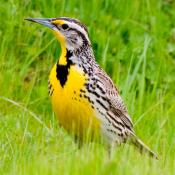
The western meadowlark is a member of the blackbird family. A male usually has two mates at the same time. The females do all the incubation and brooding, and most of the feeding of the young.
The male meadow lark uses visual display behaviors to attract a mate. When he finds a female that he wants to mate with, he points his bill in the air, puffs out his yellow throat and flaps his wings above his head. If that doesn’t get the female’s attention, he hops up and down. The western meadowlark builds its nest on the ground. The female finds a depression in the ground and shapes it by digging in the dirt with her bill. She lines the depression with soft grass and makes a roof by pulling grass and plants over the depression. She then weaves in grass to make a waterproof dome, leaving enough space for an opening. The female lays between three and seven eggs. It takes about 12 days for the eggs to hatch. The meadowlark usually has two broods a year. The male protects the nest by noisily chasing intruders away.
A male’s home range is usually about six or seven acres. If another male invades his territory, he may get into a fight with the intruder. Fighting meadowlarks lock their feet together and peck at each other with their beaks.
State bird of Kansas, Oregon, Nebraska, Wyoming, North Dakota, and Montana
Flower: Wild Prairie Rose
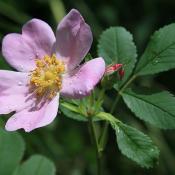
The rose is our national flower and the state flower of New York; the Cherokee rose is the state flower of Georgia; and the wild prairie rose is also the state flower of North Dakota and Iowa. The Wild Prairie Rose is not only known for its beauty but also for its medical and food uses. The rise hips and roots are used to treat inflammation of the eye. The fruit can be eaten raw or made into jellies. The stems and leaves are used in teas. Wildlife also take advantage of the wild prairie rose. Various birds, deer, antelope, elk, sheep, and pheasants feed on the rose hips. Skunks, rabbits, and gophers feed off of the fruits, stems, and foliage.
Tree: American Elm
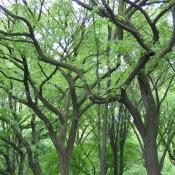
The American elm is a deciduous hermaphroditic tree. Dutch elm disease is a fungal disease that has ravaged the American elm, causing catastrophic die-offs. It has been estimated that only approximately 1 in 100,000 American elm trees is Dutch elm disease-tolerant, most known survivors simply having escaped exposure to the disease. The American elm’s wood is coarse, hard, and tough, with interlacing, contorted fibers that make it difficult to split or chop, and cause it to warp after sawing. Accordingly, the wood originally had few uses, save for making hubs for wagon wheels
State Quarter
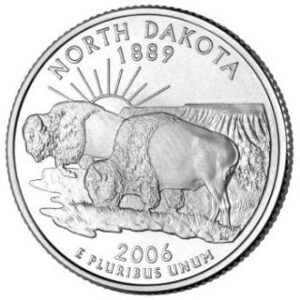
The North Dakota quarter depicts a pair of grazing American bison in the foreground with a sunset view of the rugged buttes and canyons that help define the State’s Badlands region in the background. The coin’s design also bears the inscriptions “North Dakota” and “1889.”
President Theodore Roosevelt founded the United States Forest Service and signed the Antiquities Act in 1906, which was designed to preserve and protect unspoiled places such as his beloved North Dakota Badlands, now known as Theodore Roosevelt National Park. Herds of American Bison thundered across the Badlands through the 1860s. The park is now home to more than 400 wild buffalo, an animal once on the brink of extinction.
Capital: Bismarck, North Dakota. The 19-story state capitol building in Bismarck is one of only four tower-style capitols in the U.S. An observation floor at the top provides a panoramic view of Bismarck-Mandan and the Missouri River Valley.
Nickname: Peace Garden State/ One of North Dakota’s nicknames is the Peace Garden State. This nickname honors the International Peace Garden, which lies on the state’s border with Manitoba, Canada.
Flickertail State/ Flickertail refers to the Richardson ground squirrels which are abundant in North Dakota. The animal flicks or jerks its tail in a characteristic manner while running or just before entering its burrow.
This name “Roughrider State” originated in a state-supported tourism promotion of the 1960s and 70s. It refers to the First U.S. Volunteer Cavalry that Theodore Roosevelt organized to fight in the Spanish-American War.
Motto: Liberty and union, now and forever, one and inseparable
North Dakota Facts and Trivia
Of the 50 states North Dakota is 17th in size, with 70,665 square miles. North Dakota is 212 miles long north to south and 360 miles wide east to west.
France laid claim to the land in 1682 when Robert de La Salle claimed much of the land west of the Mississippi for France. The first European to really explore the land of North Dakota was French fur trader Pierre de La Verendrye in 1738. He also established trade with the Mandan villages along the Missouri River.
In 1803, the United States bought most of North Dakota from France as part of the Louisiana Purchase. President Thomas Jefferson sent explorers Lewis and Clark to learn about and map out the new territory. Lewis and Clark entered North Dakota in the fall of 1804. In order to survive the winter they built Fort Mandan on the Missouri River where they stayed until they could continue their journey in the spring. Over the course of the winter they met with the leaders of the Mandan tribe. (In 1837 the majority of the Mandan Indians were killed by a smallpox outbreak.) They also met French trader Toussaint Charbonneau and his Shoshone Indian wife, Sacagawea. Sacagawea would later serve as a guide and interpreter for Lewis and Clark.
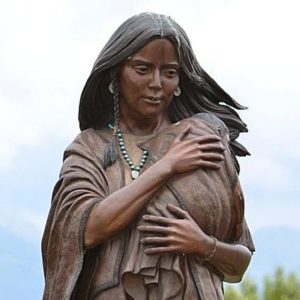 A 12-foot-high bronze statue of Sacagawea and her baby son Baptiste stands at the entrance to the North Dakota Heritage Center on the state capitol grounds in Bismarck.
A 12-foot-high bronze statue of Sacagawea and her baby son Baptiste stands at the entrance to the North Dakota Heritage Center on the state capitol grounds in Bismarck.
In 1861, North Dakota became part of the Dakota Territory which included present day North Dakota, South Dakota, and some of Wyoming and Montana.
It was named for the Dakota Indian tribe. Dakota is a Sioux word meaning friends or allies.
North Dakota continued to grow in the 1870s and 1880s with the arrival of the railroad.
1871 – The city of Fargo was founded.
1883 – Bismark became the capital of the territory.
On November 2, 1889 North Dakota was admitted to the Union. It was admitted at the same time as South Dakota.
The town of Rugby is the geographical center of North America. A rock obelisk about 15 feet tall, flanked by poles flying the United States and Canadian flags marks the location. The Canadian provinces of Saskatchewan and Manitoba border North Dakota on the north.
An attempt to drop the word North from the state name was defeated by the 1947 Legislative Assembly. Again in 1989 the Legislature rejected two resolutions intended to rename the state Dakota.
North Dakota has several large road-side attractions:
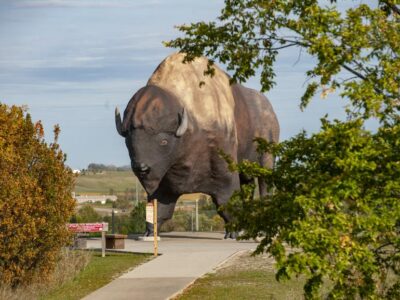 The World’s Largest Buffalo monument is located at Frontier Village in Jamestown. The structure is 26 feet high, 46 feet long, and weighs 60 ton. See Difference between bison and buffalo. It is not unusual to hear bison referred to as buffalo but they are different species. Buffalo have never been found in North America.
The World’s Largest Buffalo monument is located at Frontier Village in Jamestown. The structure is 26 feet high, 46 feet long, and weighs 60 ton. See Difference between bison and buffalo. It is not unusual to hear bison referred to as buffalo but they are different species. Buffalo have never been found in North America.
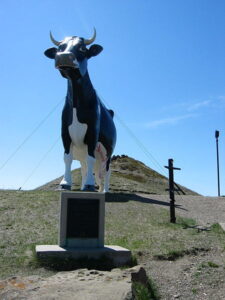 The “World’s Largest Holstein Cow,” Salem Sue, was built to honor the dairymen of the area. She is 38 feet high and 50 feet long, and is visible for five miles.
The “World’s Largest Holstein Cow,” Salem Sue, was built to honor the dairymen of the area. She is 38 feet high and 50 feet long, and is visible for five miles.
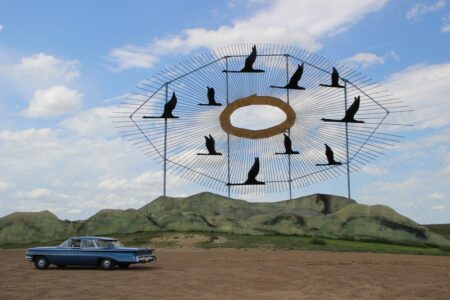 A North Dakotan highway sculpture named “Geese in Flight” holds the Guinness World Record as the largest metal sculpture in the world. Erected in 2001, it is 156 feet long, 100 feet tall, and weighs 75 tons. Retired schoolteacher Gary Greff, who wanted to break up the tedium on the highway, constructed it. Website amusingplanet.com has pictures of other projects by Greff which are on the “Enchanted Highway” (a 32-mile stretch of highway starting at Exit 72 on Interstate 94, about 20 miles east of Dickinson, in the southwestern part of North Dakota). depicting geese, deer, pheasants, grasshoppers, Teddy Roosevelt, and even a complete Tin Family.
A North Dakotan highway sculpture named “Geese in Flight” holds the Guinness World Record as the largest metal sculpture in the world. Erected in 2001, it is 156 feet long, 100 feet tall, and weighs 75 tons. Retired schoolteacher Gary Greff, who wanted to break up the tedium on the highway, constructed it. Website amusingplanet.com has pictures of other projects by Greff which are on the “Enchanted Highway” (a 32-mile stretch of highway starting at Exit 72 on Interstate 94, about 20 miles east of Dickinson, in the southwestern part of North Dakota). depicting geese, deer, pheasants, grasshoppers, Teddy Roosevelt, and even a complete Tin Family.
North Dakota grows more sunflowers than any other state. The state also leads the nation in production of spring wheat, durum wheat, dry edible peas, dry edible beans, honey, flaxseed and canola. And it is also the No. 1 producer of honey in the nation.
North Dakota is home to more wildlife refuges (63) than any other state. Wildlife viewing and birding opportunities are abundant.
Lake Sakakawea has more shoreline than the California Pacific Coast.
Kenmare is the Goose Capital of North Dakota. Kenmare is the hunting haven of the north with an annual snow goose count being over 400,000 birds.
President Theodore Roosevelt first came to Dakota Territory in September 1883 to hunt bison. Before returning home to New York, he became interested in the cattle business and established the Maltese Cross Ranch and the Elkhorn Ranch. He once said “I never would have been President if it had not been for my experiences in North Dakota.”
The Republican Party presidential candidate usually carries the state; in 2004, George W. Bush won with 62.9% of the vote. Of all the Democratic presidential candidates since 1892, only Grover Cleveland (1892, one of three votes), Woodrow Wilson (1912 and 1916), Franklin D. Roosevelt (1932 and 1936), and Lyndon B. Johnson (1964) received Electoral College votes from North Dakota. (In 1904 Theodore Roosevelt, Republican, received 75% of the vote.)
From Reader’s Digest The 50 Funniest Jokes About All 50 States
North Dakota: What’s a seven-course meal in North Dakota? A hamburger and a six-pack.
And From Reader’s Digest – The Most Difficult to Pronounce Names from each state
North Dakota: Palermo. Chalk another one up to the foreign cities that don’t translate. Palermo, North Dakota, is not pronounced like its Italian counterpart (Pah-LAIR-Mo), but rather, as PAL-er-mo.
Strange Laws
In North Dakota, it’s illegal to lie down and fall asleep with your shoes on.
Beer and pretzels can’t be served together in any North Dakota bar or restaurant.
It’s illegal to shoot an Indian on horseback in North Dakota, provided you’re in a covered wagon.
It’s illegal to keep an elk in a sandbox in your backyard.
Operators of underground coal mines must provide an “adequate supply” of toilet paper for each toilet.
Charitable groups are allowed to hold stud poker games to raise money, but ONLY twice a year.
People:
From Theodorerooseveltcenter.org
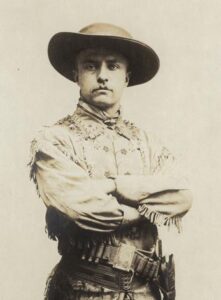
Theodore Roosevelt arrived in the badlands of North Dakota on September 8, 1883. He was 24 years old. He came to kill a buffalo, but he fell in love with the badlands of the Little Missouri River Valley. He impulsively invested in two ranches: the Maltese Cross seven miles south of the Northern Pacific railroad tracks, and the Elkhorn, 35 miles north.
Roosevelt was determined to get a taste of the American frontier before it was gone forever, to establish himself as a big game hunter, a rancher, and an authentic cowboy, and to overcome both his physical infirmities (principally asthma) and the grief he experienced when both his wife and mother died on Valentine’s Day 1884. He threw himself into badlands life – stopping stampedes, participating in month-long roundups, arresting thieves, punching out a drunken gunslinger in a bar, and helping to organize the region’s first stockmen’s association. In Dakota Territory Roosevelt was transformed from a frail and somewhat snobbish New York “dude” into the more democratic exemplar of the strenuous life who became the 26th President of the United States.
Although he relinquished most of his ranch holdings after the disastrous winter of 1886-87, he continued to maintain some cattle interests in the badlands until he became the Vice President of the United States in 1901. Even thereafter, he frequently visited western North Dakota to hunt and refresh his soul in the badlands, where he said “the romance of my life began.”
Roosevelt’s last visit to North Dakota came in the fall of 1918, just a few months before his death at the age of 60.
- Angie Dickinson actress
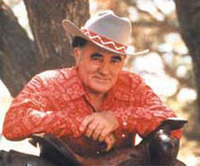 Louis L’Amour author
Louis L’Amour author- Peggy Lee singer
- Eric Sevareid TV commentator
- Ann Sothern actress
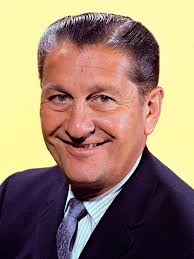 Lawrence Welk band leader, entertainer
Lawrence Welk band leader, entertainer
Music
North Dakota Hymn (state song)
Tigirlilly – North Dakota by Kendra and Krista Willow
Summer Hands by Chuck Suchy
I Got a Gal I Love in North and South Dakota by Frank Sinatra
My Home in North Dakota by Adam Taylor
North Dakota by Chris Knight
Winds of North Dakota by Mike Piper
North Dakota Home by Lawrence Welk & His Orchestra
Credits
See 50 states.com
See ducksters.com
See Only In Your State.com
See North Dakota Tourism.com
See Amusing Planet.com
See Theodore Roosevelt Center.org
